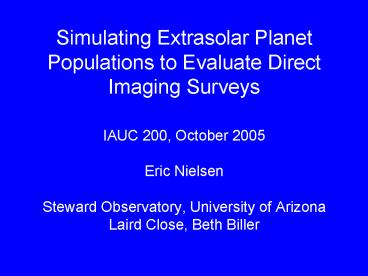Simulating Extrasolar Planet Populations to Evaluate Direct Imaging Surveys - PowerPoint PPT Presentation
1 / 20
Title:
Simulating Extrasolar Planet Populations to Evaluate Direct Imaging Surveys
Description:
Simulating Extrasolar Planet Populations to Evaluate Direct Imaging Surveys ... typically further away: limiting guide star magnitude is an important consideration. ... – PowerPoint PPT presentation
Number of Views:33
Avg rating:3.0/5.0
Title: Simulating Extrasolar Planet Populations to Evaluate Direct Imaging Surveys
1
Simulating Extrasolar Planet Populations to
Evaluate Direct Imaging Surveys
- IAUC 200, October 2005
- Eric Nielsen
- Steward Observatory, University of Arizona
- Laird Close, Beth Biller
2
Motivation
- Direct imaging surveys for extrasolar planets are
becoming more sensitive - The next generation of extreme adaptive optics
systems (ExAO) is being planned now - It's important to have a framework in which to
evaluate design choices, target selection, and
survey results (even null results!)
3
Target Selection
- Possible targets limited to nearest, youngest
stars - There are only 100 targets suitable for
direct-imaging planet searches! - Target quality depends on age, distance, and
spectral type
4
The Starting Point Contrast Curves
- Each planet-finding system is characterized by
some curve like these - How do these curves translate to what we really
care about number of planets detected?
5
Strategy
- For each target star, simulate an ensemble of
planets (106, say) - Randomly assign
- semi-major axis, mass, and eccentricity based on
assumed distributions of planets - orbital phase and viewing angle based on Kepler's
laws and geometric arguments - Combination of these give separation on the sky
- Assign H magnitude to each planet based on mass
and system age, using theoretical models (e.g.,
Burrows et al. 2003) - Determine what fraction lie above contrast curve
6
Mass Distribution
- Assume power law distribution (with high and low
mass cut-offs) - Expect a bias against radial velocity detections
at lower masses
7
Semi-major Axis Distribution
- Again, assume a power law with cut-offs at the
high and low end - Radial velocity searches are limited by the time
baseline of the survey (currently at 6 AU)
8
Eccentricity Distribution
- Just assumed to be some smooth function, as fit
to the radial velocity distribution. - Mass, semi-major axis, and eccentricity most
likely aren't independent
9
Simulation Example
- VLT NACO SDI sensitivity curve based on 40
minutes of data - Blue points are detected planets, Red
non-detections (5-sigma) - For this star, expect to detect 6 of planets
10
Survey Size and Planets Detected
- Expect to find the most planets from the 30 best
target stars - Slow gain after that in planets detected as
survey size is increased
11
Trends with Age
- Younger planets are brighter, easier to detect
- Very little expected value in observing older (gt1
Gyr) targets
12
Trends with Distance
- Planets around nearby stars are easier to detect
- Outer working radius is only a factor for target
stars within 5pc (most planets are in the inner
arcsecond)
13
Trends with Exposure Time
- As expected, slow gain with increasing exposure
time - Amount of time devoted to each target becomes
unwieldy for t gt 10,000s
14
Trends with Spectral Type
- Planets around a star of later spectral type are
easier to detect a more favorable delta-H - With latest spectral types, worry about declining
strehl - Are planets less common around M dwarfs?
15
Masses
- Each point is an individual target star the
median planet mass of all detected planets - Higher probability targets are the ones where
more low-mass planets are detected (more planets
at lower masses)
16
Semi-major Axis
- Each point is an individual target star the
median orbital semi-major axis of all detected
planets - More planets are at smaller semi-major axes.
17
Separation
- Each point is an individual target star the
median observed separation from parent star of
all detected planets - The key to detecting planets is the inner
fraction of an arcsecond
18
Strehl Ratio and Guide Stars
- Strehl Ratios decline with fainter guide stars
- More complex AO systems require brighter guide
stars (only so many photons to go around)
19
Available Targets
- Many of the best targets for direct-imaging
planet searches are faint stars - Important to consider target selection and
limiting magnitude of AO system when designing
ExAO systems
20
Conclusions
- These basic simulations can inform target
selection and survey analysis for existing AO
systems, as well as design of ExAO systems - The ability to reach the smallest separations
(inner working radius) defines the ultimate
success of the system - Most of the best target stars are faint, both
because they tend to be later spectral type, and
the youngest stars are typically further away
limiting guide star magnitude is an important
consideration.































